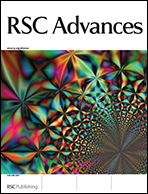Ionic liquid-based fluorescein colorimetric pH nanosensors†
Abstract
A novel pH sensitive, colorimetric ionic liquid nanosensor based on phosphonium salts of fluorescein is reported. Herein, fluorescein salts of various stoichiometries were synthesized by use of a trihexyltetradecylphosphonium cation [TTP]+ in combination with dianionic [FL]2− and monoanionic [FL]− fluorescein. Nanomaterials derived from these two compounds yielded contrasting colorimetric responses in neutral and acidic environments. Variations in fluorescence spectra as a function of pH were also observed. Examination of TEM and DLS data revealed significant expansion in the diameter of [TTP]2[FL] nanodroplets in acidic environments of variable pHs. A similar trend was also observed for [TTP][FL] nanoparticles. The pH dependent colorimetric and other optical properties of these nanomaterials are attributed to alterations in molecular orientations and stacking as suggested by measuring the absorption, fluorescence, and zeta potential. Since the pH is an important indicator for many diseases, including cancer, these nanosensors are considered to be potential candidates for biomedical applications.


 Please wait while we load your content...
Please wait while we load your content...